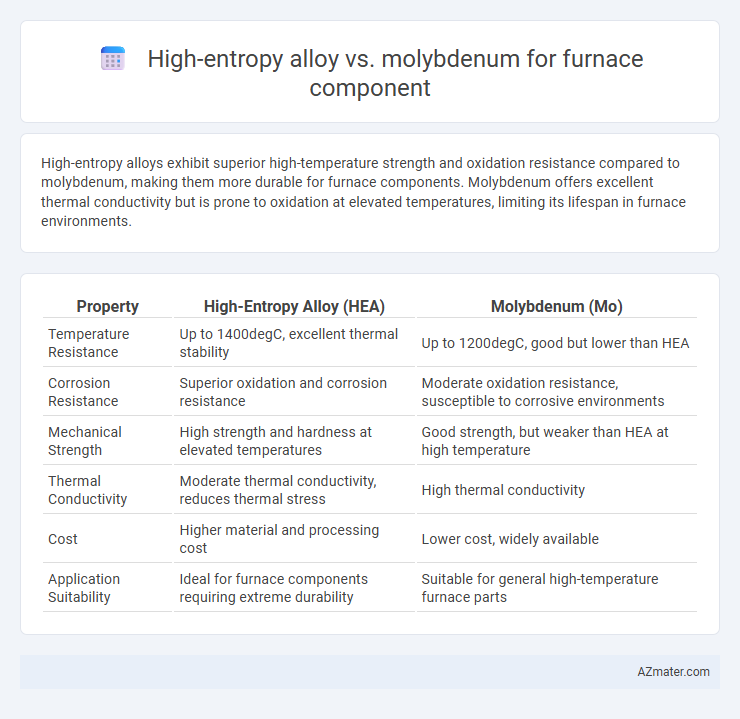High-entropy alloys exhibit superior high-temperature strength and oxidation resistance compared to molybdenum, making them more durable for furnace components. Molybdenum offers excellent thermal conductivity but is prone to oxidation at elevated temperatures, limiting its lifespan in furnace environments.
Table of Comparison
| Property | High-Entropy Alloy (HEA) | Molybdenum (Mo) |
|---|---|---|
| Temperature Resistance | Up to 1400degC, excellent thermal stability | Up to 1200degC, good but lower than HEA |
| Corrosion Resistance | Superior oxidation and corrosion resistance | Moderate oxidation resistance, susceptible to corrosive environments |
| Mechanical Strength | High strength and hardness at elevated temperatures | Good strength, but weaker than HEA at high temperature |
| Thermal Conductivity | Moderate thermal conductivity, reduces thermal stress | High thermal conductivity |
| Cost | Higher material and processing cost | Lower cost, widely available |
| Application Suitability | Ideal for furnace components requiring extreme durability | Suitable for general high-temperature furnace parts |
Introduction to Furnace Component Materials
Furnace components require materials with exceptional thermal stability, corrosion resistance, and mechanical strength to withstand extreme operating conditions. High-entropy alloys (HEAs) offer a novel approach by combining multiple principal elements to enhance high-temperature strength and oxidation resistance compared to traditional molybdenum components. Molybdenum remains a benchmark for furnace parts due to its excellent thermal conductivity and resistance to creep, but HEAs provide potential improvements in performance and durability through their complex microstructures.
Overview of High-Entropy Alloys (HEAs)
High-entropy alloys (HEAs) consist of five or more principal elements in near-equiatomic proportions, resulting in unique microstructures with superior mechanical strength and thermal stability compared to traditional alloys. Their high configurational entropy enhances phase stability at elevated temperatures, making them promising candidates for furnace components exposed to extreme thermal stress. HEAs exhibit excellent oxidation resistance and creep properties, often outperforming conventional refractory metals like molybdenum in high-temperature industrial applications.
Properties of Molybdenum in High-Temperature Applications
Molybdenum exhibits exceptional high-temperature strength, excellent thermal conductivity, and outstanding resistance to creep and thermal expansion, making it highly suitable for furnace components exposed to extreme heat. Its melting point of 2,623degC and low vapor pressure under high temperatures ensure structural stability and longevity. Compared to high-entropy alloys, molybdenum offers superior oxidation resistance in reducing atmospheres, making it a preferred choice for high-temperature furnace applications.
Thermal Stability: HEA vs Molybdenum
High-entropy alloys (HEAs) exhibit superior thermal stability compared to molybdenum due to their multi-element composition, which enhances resistance to oxidation and creep at elevated temperatures. Molybdenum, while possessing high melting points (2623degC), is prone to rapid oxidation and embrittlement in furnace environments without protective coatings. HEAs maintain mechanical integrity and phase stability beyond 1100degC, making them more suitable for harsh high-temperature furnace components requiring prolonged thermal exposure.
Oxidation and Corrosion Resistance Comparison
High-entropy alloys exhibit superior oxidation resistance compared to molybdenum due to their stable, multi-element oxide layers that inhibit rapid scale formation at high temperatures. In contrast, molybdenum suffers from rapid oxidation and volatile oxide formation above 600degC, limiting its durability in furnace environments. Corrosion resistance in high-entropy alloys is enhanced by their complex composition, which improves passivation and reduces degradation in aggressive atmospheres compared to molybdenum's relatively lower resistance to acidic and oxidizing gases.
Mechanical Strength under Extreme Conditions
High-entropy alloys exhibit superior mechanical strength and thermal stability compared to molybdenum when subjected to extreme furnace conditions, including high temperatures and cyclic thermal stresses. The multi-element composition of high-entropy alloys enhances their resistance to oxidation and creep deformation, outperforming the traditional molybdenum components known for brittleness at elevated temperatures. This makes high-entropy alloys a more durable and reliable choice for furnace components requiring longevity and resilience under harsh operational environments.
Fabrication Challenges and Processability
High-entropy alloys (HEAs) exhibit complex microstructures that pose significant fabrication challenges due to their multi-element compositions, requiring advanced control over melting and solidification processes to achieve homogeneity. In contrast, molybdenum benefits from well-established processing techniques like powder metallurgy and forging but suffers from brittleness and high melting points that complicate machining and forming operations. Processability issues in HEAs include difficulty in welding and potential phase segregation, while molybdenum's susceptibility to oxidation necessitates protective atmospheres during furnace component manufacturing.
Cost Analysis: High-Entropy Alloys vs Molybdenum
High-entropy alloys (HEAs) offer superior mechanical properties and thermal stability compared to molybdenum, but their cost remains significantly higher due to complex fabrication methods and expensive constituent elements. Molybdenum is a cost-effective option with established supply chains and machining processes, although its susceptibility to oxidation at elevated temperatures may lead to increased maintenance expenses. Cost analysis reveals that while molybdenum offers lower upfront investment, HEAs can provide long-term economic benefits through enhanced durability and reduced downtime in furnace components.
Longevity and Maintenance Requirements
High-entropy alloys exhibit superior longevity compared to molybdenum in furnace components due to their enhanced resistance to thermal fatigue, oxidation, and corrosion under extreme operating conditions. Molybdenum, while having high melting point and thermal conductivity, requires more frequent maintenance because of its susceptibility to embrittlement and oxidation at elevated temperatures. The reduced maintenance intervals and improved durability of high-entropy alloys contribute to lower operational costs and increased furnace uptime.
Application Suitability for Furnace Components
High-entropy alloys (HEAs) offer exceptional thermal stability, oxidation resistance, and mechanical strength at elevated temperatures, making them highly suitable for furnace components exposed to extreme conditions. Molybdenum exhibits excellent high-temperature strength and thermal conductivity but suffers from oxidation issues at temperatures above 600degC, limiting its long-term application in oxidative furnace environments. HEAs outperform molybdenum in complex thermal cycles and corrosive atmospheres, providing enhanced durability and reduced maintenance for furnace components.

Infographic: High-entropy alloy vs Molybdenum for Furnace Component
 azmater.com
azmater.com